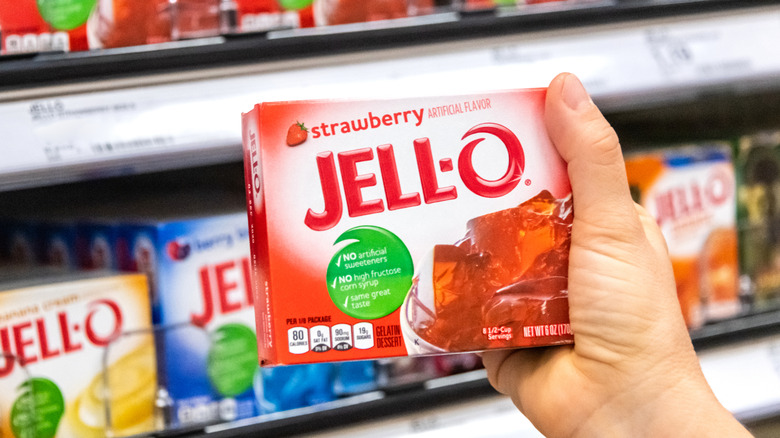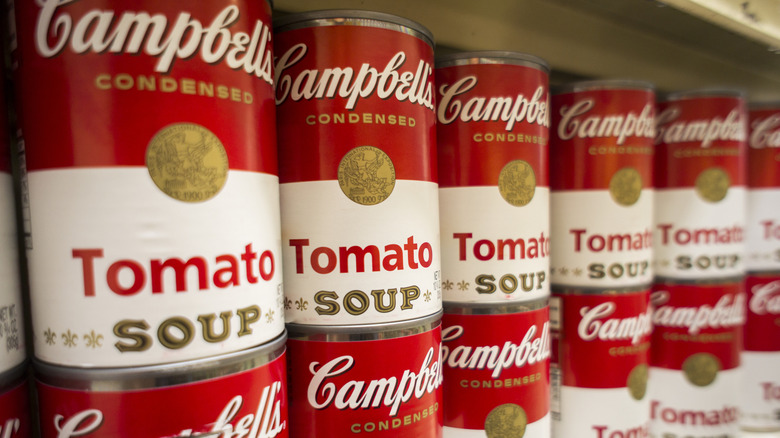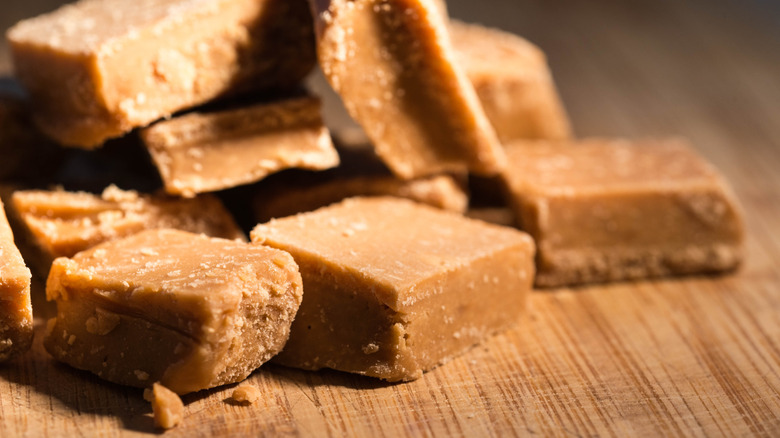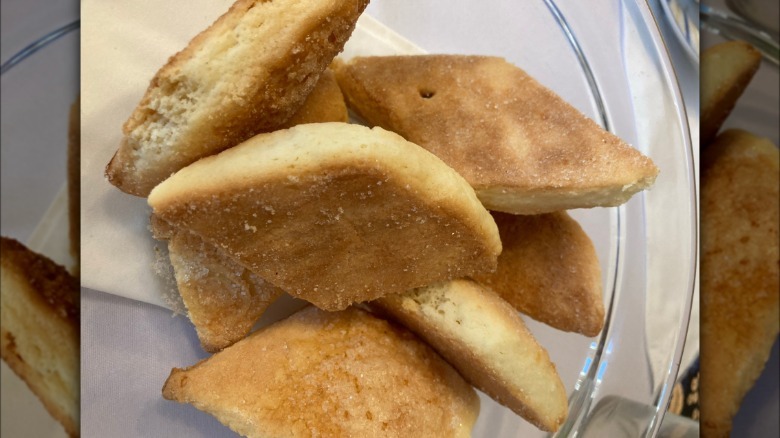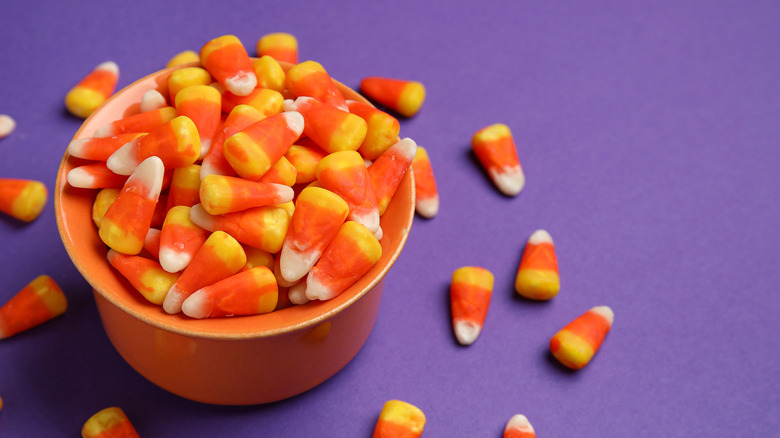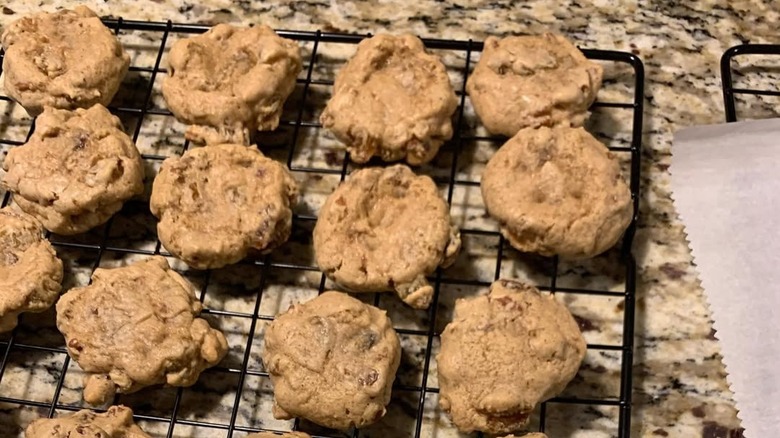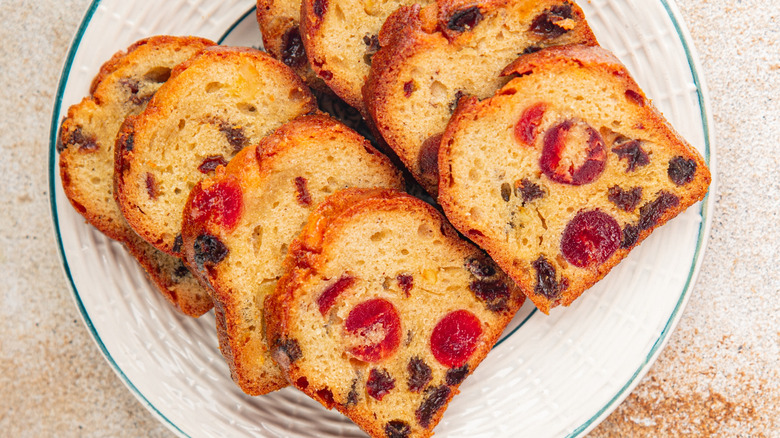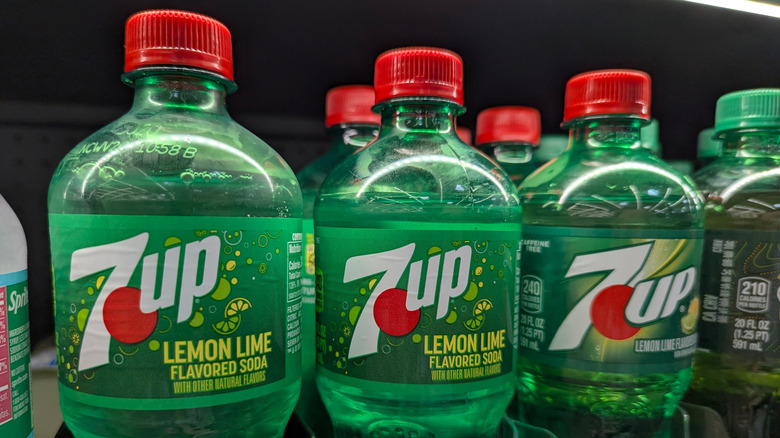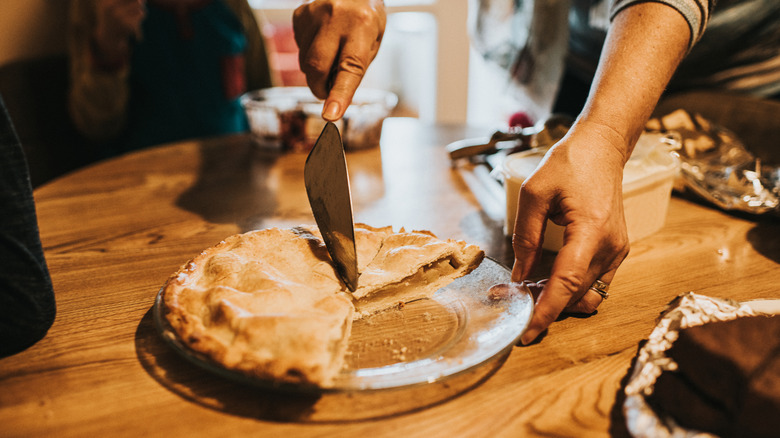12 Old School Desserts No One Makes Anymore
Desserts have been enjoyed around the world for centuries. Some have even stood the test of time like fruitcake, cheesecake, and ashure — a Turkish dessert often referred to as Noah's pudding after the tale of it first having been made by Noah after surviving the great flood. Over time, these dishes have evolved as recipes and ingredients shifted to suit changing needs and wants. However, not every dessert can make its mark across centuries, and some lose their foothold after mere decades or even years.
That's not to say that these desserts weren't at one time a byproduct of necessity or a snapshot of the world where they were created. In fact, many desserts (and meals, for that matter) speak to the social needs of the population during that time. In times of rationing or inflation, at-home cooks would use ingredients they had on hand — or ones that were easily accessible and affordable — to make due. When luxuries like butter, milk, and eggs were more readily available, these recipes often fell by the wayside in favor of recipes that had richer flavors. On the other hand, some recipes simply didn't last due to generational differences in taste and we're sharing twelve desserts that, for one reason or another, aren't as popular in the recipe Rolodex anymore.
Tuna and Jell-O pie
Gelatin has long been a part of diets around the world, often from the painstaking process of rendering collagen from animal bones. As with anything that took a great deal of time, it often was seen as a sign of wealth and prosperity even all the way back in medieval Europe. As technology got more sophisticated, Jell-O came onto the market as an efficient, affordable way to make gelatin foods by the end of the 19th century.
Due to its affordability and the incredible marketing campaigns by companies like Jell-O, gelatin salads became all the rage, particularly in the '70s. One such "salad" was the summer salad pie, better known by its ingredients of gelatin and tuna. Technically, this dish was eaten as a more savory option, but we've included it due to the lemon Jell-O layer that adds a jarring sweetness. The basic recipe uses a cheese pie crust with a lemon Jell-O, tomato sauce, onion, celery, and olive center. That is then topped with tuna salad and garnished with tomatoes. Gelatin dishes are still made across the country, but the summer salad pie has mostly been retired from the kitchen.
Tomato soup spice cake
There are plenty of interesting ingredients in desserts (we're looking at your mayonnaise and tofu), and that includes tomato soup. Yes, we mean the kind of soup that is typically paired with a delicious, melty grilled cheese. According to the Campbell's Company website, the tomato soup spice cake was first spotted in the '20s or '30s in an undated cookbook. Eventually Campbell's began running its own advertisements and writing cookbooks featuring the recipe with fillings from candied fruit to nuts. It became so popular that, in 1960, it was the first recipe to ever appear on the label of a canned soup.
To make it easier, you can use a pre-packaged spice cake box mix and combine that with water, eggs, and one can of tomato soup. The recommended topping is a cream cheese frosting (can be either store bought or homemade) and it can be made into cupcakes or a loaf if preferred. Some reviewers mention it tastes almost exactly like a normal spice cake would, but today, soup isn't always the first ingredient one thinks of when considering which dessert to have after dinner.
Velveeta fudge
While Velveeta is technically not real cheese (it's branded as a "pasteurized prepared cheese product"), it is a hot topic in the mac and cheese conversation. Some people refuse to eat it, but those that are fans tend to be loyal to the shockingly orange cheese-like block. Beyond queso or cheesy chicken skillets, Velveeta can also be used in fudge recipes. Yes, we said fudge.
The average fudge recipe uses sugar, salt, milk, butter, and other flavorings to make a pan of the much loved, creamy confection. With the Velveeta version, there's the addition of one block of the stuff alongside cocoa powder (since the recipe does best with chocolate fudge as opposed to vanilla or other flavors). The Velveeta gets melted down alongside the butter then added into the dry ingredients and mixed until stiff before getting pressed into a square pan. Those who love the recipe say that they don't taste the Velveeta at all, but reap the benefits of its creaminess in each bite.
Potato candy
Potatoes have long been seen as an incredibly versatile vegetable. They can be mashed, steamed, roasted, fried, baked, sauteed and included in breakfast, lunch, dinner, and even dessert recipes. One of those dessert recipes is potato candy– it's thought to have origins in the Appalachian region of the United States, particularly during the Great Depression. As with any time of hardship, families had to make due with what they had access to and potatoes have long been a cheaper option much like carrots, onions, and cabbage. Today, it's a recipe that stands as a reminder of familial traditions and heritage.
The genius of the dessert is that it requires three ingredients: potatoes, peanut butter, and powdered (or confectioners) sugar. To start, the potatoes need to be boiled to tenderness then mashed until smooth. The potatoes then get mixed with the powdered sugar and shaped into a log then pressed into a rectangle. From there, peanut butter is slathered in a layer before it's rolled back into a log. Once firm, it can be cut into slices and enjoyed.
Ammonia cookies
Before we begin, we need to be clear that ammonia cookies are not made with the ammonia that people use as a cleaning product in their homes. These cookies are made with baking ammonia, which isn't a pantry staple in every home. Baking ammonia is used as a leavening agent in baked goods and was the de facto leavening agent prior to the invention of baking soda and baking powder. Due to the rise in popularity of baking soda and powder, baking ammonia lost much of its market share, though it's still used in many traditional European recipes.
Baking ammonia typically results in a rather crispy and thin baked good, which is the exact texture of an ammonia cookie. These cookies are also sometimes referenced as hartshorn, which is the antler of a male red deer that used to make up baking ammonia. The other ingredients for these cookies are easy to source like sour cream, eggs, sugar, butter, flour, and salt, but bakers' ammonia itself can be difficult to find in stores.
Candy corn on the cob
One of the most controversial candies of all time, candy corn has humble agricultural roots. While it's mostly associated with Halloween, candy corn was among many other treats shaped like vegetables that candy companies marketed to farming families year-round starting back in the late 19th century. In fact, candy corn was actually marketed as "Chicken Feed" to consumers. Corn was pushed as an alternative food source to wheat during World War I, and in the years following the war, chicken marketing was phased out.
Candy corn on the cob turns the candy's name into a literal treat of corn-shaped confections, and it was especially popular due to the affordability of candy corn, particularly when bought in bulk. To make a candy corn on the cob, it requires making edible sugar cookie dough. That means no eggs and no raw flour can be used in the recipe in order to make it safe for eating. Once the dough has been created, it's a matter of rolling it into logs and then painstakingly sticking candy corn pieces around the log until it resembles a corn cob. Considering the sheer number of candy corn pieces required, it's not a great experiment to undertake for those averse to its overly sweet flavor.
Hermit Cookies
The hermit cookie has a storied history on the East Coast of the United States in the 19th century, with some claiming they originated in Cape Cod or as far back as Colonial times in a burgeoning United States. No matter where they came from, or when, the hermit cookie is one of many in a long line of spiced cookies that held up well through time and travel. As with any recipe, it's up for interpretation. Some people added molasses when spices like cinnamon, ginger, and clove were hard to come by during rationing, while others added raisins, dates, cranberries, or currants.
The cookies are so versatile that they can be made into bars for breakfast or a post-workout pick me up. However, you likely won't find hermit cookies — at least not with its original name — in bakeries. That's more or less down to changing tastes and more popular cookie flavors like chocolate chip, sugar, peanut butter.
Election cake
The election cake was thought to have been made for the first time in Colonial America. Back then, of course, there were no phones, emails, or billboards to promote electoral candidates to prospective voters. The idea of the election cake, it's said, was to encourage voters to not only vote, but vote for particular candidates. Back then, property-owning white men were the only ones allowed to vote, and as the saying goes, "The way to a man's heart is through his stomach." That being said, women baked these rather dense, very time consuming cakes as a powerful way to be a part of the political process.
The recipe was first printed in Amelia Simmons' cookbook, "American Cookery," and is not for the faint of heart. The cake dough requires yeast so there is some kneading required. This will go faster for those with electric mixers, otherwise your forearms will get a workout. The mix-ins include alcohol-soaked prunes and all matter of other nuts and fruits. The result is a product very similar to fruitcake — heavy and spicy.
Great cake
Created by Martha Washington — yes, the first First Lady of the United States — the great cake is much like desserts of old that leaned heavily on dried fruit, nuts, and brandy. Brandy helped to not only moisten these cakes, but it ensured that the cakes in question held up over time. After all, there was no refrigeration and food had to maintain shelf life if they used valuable ingredients. The great cake was served at occasions like tea time, dinners, and big holiday celebrations around Christmas.
A version of Martha's recipe — which was written out by her granddaughter, Martha Parke Custis — required an intense amount of ingredients. We're talking forty eggs alongside several pounds of butter, sugar, flour, and candied fruit for each cake. However, another iteration of her recipe called for a peck of flour (that's eight to ten pounds of the stuff), alongside seven pounds of currants and three pounds of melted butter. According to Custis' transcription, the cake then baked for a whopping five-and-a-half hours.
7-Up salad
Would you believe it that 7-Up was originally marketed as a medicinal beverage? Back in 1929, businessman Charles Leiper Grigg concocted 7-Up to help folks combat hangovers, thanks to one of its original ingredients, lithium citrate. Today, lithium citrate is used as a medication to help treat a whole host of mental health disorders like manic-depressive disorder by stabilizing moods and reducing behavioral extremes. Eventually, it was reformulated, rebranded, and marketed as any other typical American soda brand.
Its use in Jell-O salads became popular in the '70s, resulting in the fluffy, citrusy salad we know today. Most recipes call for 7-Up, lime or lemon Jell-O, fruit, and some variation of marshmallows. The resulting texture is an interesting one, especially if nuts are added. For a creamier texture, some recipes call for softened cream cheese to be added to the Jell-O mixture when it's hot. Today, Jell-O salads are still loved in the Midwestern United States and recipes continue to be handed down.
Mock Apple Pie
As the name suggests, mock apple pie isn't apple pie at all — there aren't apples in it. That's right: mock apple pie may smell like apple pie when cooking in the oven, but it's a fruitless dessert born from times when apples were hard to come by or scarce. Most recipes today use Ritz crackers, but the recipe is thought to date back to the mid-19th century when cooks needed to get creative without fruits to rely on for sweetness and flavor.
It's made by boiling whole Ritz crackers (or some other buttered cracker) in water until soft. That gets poured into a pie crust and topped with even more crushed crackers mixed with butter and brown sugar. The resulting texture and flavor taste is said to be just like an apple pie, so much so that some cooks claim people couldn't tell the difference, but we'll let any brave bakers test that theory.
Ration Cake
Rationing in the United States was perhaps not ever as strict and widespread as during World War II. Items began being rationed in the weeks following the attack on Pearl Harbor, starting with tires. From there, rationing spread to most everyday products from sugar, bacon, and coffee to gasoline and bicycles. Rationing boards across the country popped up to help ensure ration mandates were being followed and to help the war effort. Women at home worked diligently to create recipes for their families that were both filling and delicious while using what they had on hand.
Ration Cake, also called War Cake and Depression Cake, is made without many of the standard ingredients we use in cakes today. It has no milk, no eggs, and no butter. One recipe from Crisco called for water, brown sugar (or regular sugar and molasses if that was unavailable), Crisco, flour, salt, spices, baking powder, and baking soda — that's it. Some would add cocoa powder, if it was available. No matter the variations, the cake stands as a testament to the perseverance of all the populations who enjoyed it.

